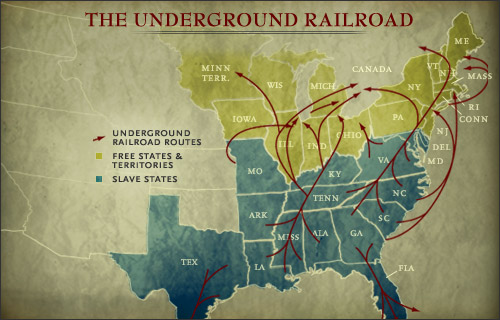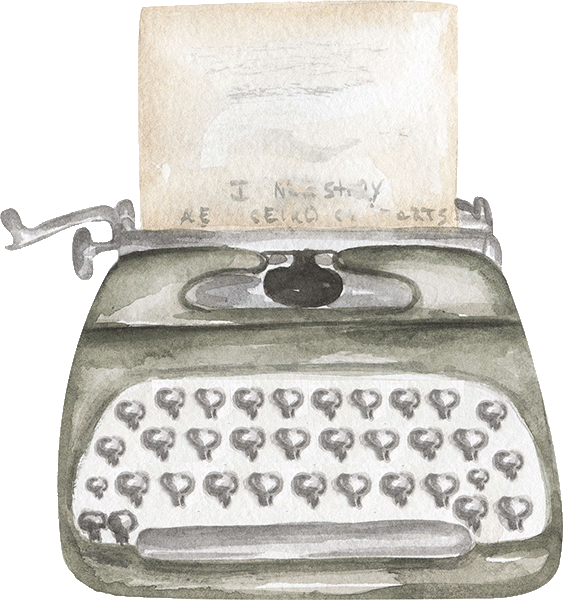
When you read that title, you probably rolled your eyes a little. “Oh, no, now she’s doing boring ol’ history posts. Reveries is going to the dogs. Time to unsubscribe …”
Well, stop right there. No unsubscribing is allowed. First, you’re going to enjoy this post. Second, if ‘first’ proves untrue, you should know that I probably won’t be making a lot of posts like this because I never research … so ….
Okay, I’m kidding. I do research sometimes. Just … less than I should.
As you may or may not know, I’m writing a historical fiction novel, Once a Stratton, for Camp NaNoWriMo (12K now!). This book features the Underground Railroad. For this, I had to do a little (hehehe) research.
So. Today I’m briefly sharing what I’ve learned with you. In the form of an interview.
What is the Underground Railroad?

From about 1800 to 1860, as many as 100,000 (the number is greatly debated) slaves escaped through the Underground Railroad. Only a small percentage of the slaves in the southern United States (an estimated 4 million existed in 1860) escaped, but 100,000 is still an impressive number.
This was an illegal network of secret routes (“tracks”) and safe houses (“stations”) which escaped (African-American) slaves used on their way to reach the “Promised Land” or “terminal,” Canada. Slaves would also escape to Florida, Mexico, or the West.
There was no actual train, no actual tracks. However, this term – first used around 1840, from what I can tell – was a safe way of discussing this top-secret operation. They also used words such as “package” and “freight” to describe the escapees and “conductor” or “operative” to discuss the Abolitionists aiding the slaves.
What were “safe houses”?

Safe houses, a.k.a. “stations”, were usually in the northern United States though a few probably existed in the south. They consisted of a sympathizer’s house, barn, or cellar where slaves could hide during the day. Churches were also common safe houses. They might even use a cave if nothing else was available in the area. At night, they would begin their travels again.
“Stations” oftentimes had secret compartments, some of which are still existing today.
Did most slaves have help escaping or did lots have to go it alone?

Technically, the Underground Railroad was a series of Abolitionists helping slaves. These Abolitionists were sometimes Quakers (or other whites) as is most commonly believed, but freed slaves were the most common “conductors.” Still, there were quite a few non-African-American people working to free the slaves.
However, many slaves did escape without any help from the Underground Railroad. Usually, slaves would choose to escape on their own without being prompted by a member of the Railroad (such as an “agent”, who would seek out slaves in the south to help), and they would later receive help from people along the way. There was often little help available until they got to the North, after which they would simply slip from house to house.
There is also no physical evidence that quilts, lanterns, or any other kind of sign – at least not one that wasn’t changed frequently – was used to guide slaves from safe house to safe house. These are appealing but impractical ideas.
And the Southerners just calmly ignored all this?

Ohhhh, no! The slave-owners didn’t take kindly to the Railroad. That was why all this had to be such a big secret! They hired bounty hunters. The escaped slaves and those helping them had to travel only by night, quickly and quietly, in constant fear of these ‘slave-catchers.’
Remember, this was also illegal. Members of the Railroad took a huge risk every time they travelled South, and they were only able to help a few escape every time. Harriet Tubman herself “only” made nineteen trips. That is a great many more than most risked, and she was definitely one the bravest women in the history. I’m honestly becoming a fan of “Moses.”
How does all this work into my novel?

In Once a Stratton, Chris and Lilli eventually get involved in the Railroad through Lilli’s Quaker friends. (It makes sense … they’re in Philadelphia, Quakers are in Philadelphia, most Quakers don’t support slavery, some Quakers are members of or supporting the Railroad …)
They make three or four trips into the South to help escaped slaves, almost getting caught during the last one. They also do some other stuff, but I’m not going to give you all the details. This post is long enough already for a “short” post. 😉
Now, here’s the thing … I’m not 100% sure all of that is 100% fact. I did my best using Google, Wikipedia, and various history sites that I believe are reliable. I tried to separate myth from fact, compare different information I got, and use common sense.
And I think I got it right.
If you are an Underground Railroad scholar, don’t be shy about telling me of any mistakes you notice.
Until Friday,
Ta-ta!
~Kellyn Roth~
Bloglovin’ · Pinterest · Facebook
p.s.
How much of that did you know? Did you enjoy this post or should I never post such a horror again? Did you find any of this interesting?
How’s Camp NaNoWriMo going for you? Are you satisfied with your word/page/etc. count? Are you pleased with the work you’ve done?


25 Responses
Oh, fun! I did a lot of research on the Underground Railroad when I was younger, partially because my state played a good role in it. I didn’t see this in here, but I might have missed it; people would set up traps pretending to be safe houses sometimes so they could earn reward money.
Yeah, I didn’t include that, though I’ve heard a little bit about it.
Last week I just completed an essay about the Underground Railroad for college! If you want some more info to maybe include in your book, here are some facts that I learned in my research.
– Some slaves would use song lyrics to send secret messages to each other. Peg-leg Joe, who wrote the song, “The Drinking Gourd”, created lyrics that contained instructions for an escape. The “drinking gourd” in the song stood for the big dipper. The next words led the listener to follow the dead trees by the Tom Bigby River. “Left-foot peg-foot” meant to follow the trees with special markings on them. By following these instructions and keeping the North Star in view, it would provide a chance to make it to Tennessee.
– The slave “grapevine” was a wide array of information passed from slave to slave, and sometimes from a free man to a slave. When a white man clasped his ear while passing a black man, it was an indicator meaning for the slave to follow him to a safe-house. There were also secret handshakes that would have been used between slaves and free men.
– As the years continued, slaves came up with more imaginative ways to escape. For example, Henry Box Brown had his friend, Samuel Smith, nail him in a box, hence the middle name, and ship him to the express station. In the box, he traveled by train and went from Richmond, Virginia to Philadelphia over the course of 26 hours. When he reached Philadelphia, he was met by William Still, who wrote that when Brown got out of the box, he was so bent over, he could hardly walk. He even said that the box had been set upside-down on the train ride, causing Brown to ride on his head! Samuel Smith helped several others to escape in boxes until he was caught and sent to prison for 7 years. Another wild story occurred in 1848. William Craft disguised his light-skinned wife as a white man, and posed as the man’s servant who spoke for him and handled all the travel arrangements. They traveled by both stagecoach and train to Philadelphia and later to Boston. Once in Boston they were hidden by Lewis Hayden, who protected them by standing at his front door with a gun when the bounty hunters came around.
– The Fugitive Slave Bill of 1850 brought the government into catching escaped slaves and allowing local law officers to seize and arrest anyone with black skin in the northern states. This allowed the slaves who had suffered and triumphed in their escape, to be captured and sent back south to slavery. This continued for thirteen years until Abraham Lincoln wrote the Emancipation Proclamation.
……………………………………..
Sorry that this is such a long comment! I don’t know if this info will help you much, but I just found it interesting!
– Megan Joy
I’ve heard about all that! It’s absolutely fascinating. And what’s even more crazy is that it’s probably all true … except ‘Follow the Drinking Gourd.’ I think that’s a myth. Perhaps I’m wrong, though. 🙂
You’re probably right.
– Megan Joy
Well, maybe … I’m pretty bad about double-checking facts, I’m afraid.
Ooh, the new blog design is so pretty!
I found this super interesting. I think I knew most of it before hand, but mainly through the American Girl Addy books, so it’s been quite a few years. (and I found the title very amusing).
Heh. Heh. It’s… not? I got kinda sick for pretty much all of April so far… so… no words… *sheepish look*
Thank you!
Oh, sorry! I hope you get better soon. Sickness is really bad (duh). I’m still suffering from the after-shocks of a cold. 😉
I found this really interesting. I wouldn’t be opposed to more posts like this. I’ve been doing pretty well for CampNanowrimo but I gave myself really low expectations so I need to push myself harder……
Cool facts, Kellyn. 🙂 I am interested, however, in if the Southern states/Confeds had something to do with the Underground Railroad. I understand that you had the ones sending bounty hunters and everything, but actually helped slaves get to safety. These are not the stories you find easily, but I have read a book or two where in the Southern states, slaves were helped and moved along. I’ve tried to google this question, but haven’t found much. It sucks because I am fairly certain that many Southerns weren’t unleashing their dogs, ya know? That they had a part in taking care of their fellow people- but no one wants to share those stories, I guess.
I’m just adding that it’s unlikely ALL the Southerners were trying to punish the slaves Google may not say so, lol, but I would bet there is something out there about Confeds helping the Railroad. Maybe this could play a role in your story?
Sorry for the ramble. xD You have good facts! And my novel for Camp is going well. 🙂
Oh, no, I know that! I’ve read Gone with the Wind. 😉 Okay, I’m just kidding, but I do believe quite a few Southerners sympathized with the slaves and helped them escape or something similar. Probably not openly, though, which is probably why it’s not wide-spread knowledge. Maybe? I don’t know. It seems like it would be even more dangerous for them than for people from the north!
And it actually does play a role in my story! Well, kinda. More so in the second book in this series (assuming I decide to make it a series).
Ooh, interesting facts, Kellyn! Research is definitely a big part of writing — one I don’t take seriously enough. XD And OOH NEW BLOG DESIGN!!!
And yeah, I decided to redo the theme a little.
*waggles eyebrows*
Um … for some reason I only wrote half a reply there …
*waggles eyebrows*
How much of that did you know? None. Absolutely none of it! This is all fresh and really cool information
Did you enjoy this post or should I never post such a horror again? ENJOYED IT, This was cool unique and informative
Did you find any of this interesting? Very
Lovely Post!
Thanks, Violet! 🙂
Hey, I really like that you included book research on your blog! I think it’s a great idea (and one that I might use, myself, in the months leading up to my debut novella’s release). I knew nothing of the Underground Railroad before today, but I’m always up for learning something new. How often is fiction inspired by fact, after all? 🙂 Thanks Kellyn!
That’d be cool to see! I personally really enjoyed preparing for this post. It really helped cement the facts in my brain to tell them to someone else. 🙂
How much of that did you know? some of it but it was still interesting
Did you enjoy this post or should I never post such a horror again? IT WAS AMAZING. as a poc the UR is Close to My Heart and this was extremely informational 😀
Did you find any of this interesting? yesyesYES
How’s Camp NaNoWriMo going for you? eh… Are you satisfied with your word/page/etc. count? i just started over so no. i cut my goal in half and am trying prose have i gone temporarily insane? Are you pleased with the work you’ve done? acutally yes im pretty happy with what i have so far
I’m glad you enjoyed it. And good luck with Camp! I’m sure you can do it. 🙂
ooh a new blog design! i love it! Very Spring
Thank you 🙂